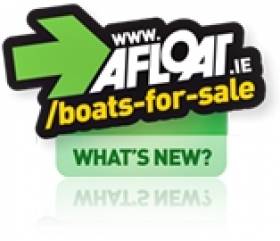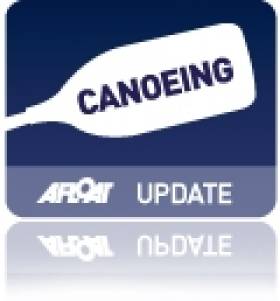Displaying items by tag: SHARE
Quarter Share Offered in Sailing Cruiser on the Med
#BOATS FOR SALE – Under the heading 'Boat (still) For Sale' the owner of the Beneteau Oceanis 411 'La Chacharoona' 'has had a few nibbles from his advert on the Afloat boats for sale site but alas so far no bites.
'Plan B' for the owner is to offer a quarter share in the vessel because he has 'less time than originally planned to visit her'. The hope is cruising sailors fed up with Irish weather will see this as a wonderful opportunity to buy in to Med cruising. She is based in MDL Marina's new facility in Sant Carles de la Rapita on the east coast, where berthing and maintenance fees compare favourably with Irish rates.
All the details and photos of La Chacharoona are here.
Shooter Hits Tramore Three Weeks Into Kayak Challenge
Elaine 'Shooter' Alexander has now reached Tramore on the south-east coast in her effort to circumavigate the island of Ireland by kayak.
Now three weeks into her solo voyage to raise funds for Share, which works for the inclusion of disabled people in water-based and other activities, Shooter is edging ever closer to the half-way point of her 1,000-mile route.
See below for a map of Shooter's current position.
Shooter Gets Ready to Kayak Round Ireland
Monaghan's Elaine 'Shooter' Alexander will soon begin her challenge to be come the first Northern Irish woman to circumnavigate the island of Ireland by kayak, the OutdoorNI Adventure Blog reports.
On 3 May she will set off from the newly refurbished County Antrim Yacht Club at Belfast Lough on a 1,000-mile trek that's expected to take two months to complete.
Alexander will be paddling clockwise around Ireland, taking on tides, cliffs, headlands - and Ireland's unpredicable weather.
The Ulster woman has been training since last year for the challenge, which is intended to raise funds for the Fermanagh-based SHARE, a charity that brings together disabled and non-disabled people in arts and outdoor-based activities.
“Last year I paddled around Ulster which took 26 days and prepared me for some of what to expect for this expedition," says the competitive kayaker, who represented Northern Ireland twice at the Surf Kayak World Championships.
'Shooter' will also be posting regular updates of her trip on Facebook, Twitter and YouTube. Details on this as well as how to donate are available on her website www.canoearoundireland.com.
The OutdoorNI Adventure Blog has more on the story HERE.
Lough Erne Canoe Rally Paddles Against Global Warming
Ireland's largest residential activity centre, Share Holiday Village is proud to announce that the third annual brites Lough Erne Canoe Rally will take place on 25th and 26th September 2010.
This year the event, which attracts paddlers from all over Ireland, is set to have more of an environmental message as SHARE was heavily affected by the Fermanagh Floods in 2009, which some have attributed to the heavy rainfall associated with Global Warming. Indeed canoeing is the perfect platform in which to promote this environmental message to local schools and businesses as it is one of the more idyllic forms of recreation that can be enjoyed on Lough Erne.
Both Share and brites are leaders in the field of renewable energy. Over the past 10 years Share has installed the largest reed-bed water purification plant in Northern Ireland and has built up an extensive portfolio of renewable technologies. These include three wind turbines, four solar water heating systems, and four wood pellet burners. The fuel for these wood pellet burners is supplied by Balcas, the manufacturers of brites. Share can now boast of using 99% renewable electricity on site, and 90% renewable heat, resulting in a total overall offset of CO2 of almost 300 tonnes.
Paula Keelagher, brites Technical Development Manager, at Fermanagh based Balcas comments: "We are delighted to be supporting the Lough Erne Canoe Rally once again. It has been great to see the event develop over the last two years and we look forward to seeing many local companies, schools and organisations taking part this year. We will of course be entering into the spirit of the competition with our own brites team and wish everyone who is participating the best of luck."
Chris Scott, Marketing Officer, Countryside Access and Activities Network (CAAN) which the event also helps to promote comments; "It is great to see Share hosting such a professionally organised event on the Lough Erne Canoe Trail. The brites Lough Erne Canoe Rally is a fantastic showcase for this award winning trail. The event doesn't take itself too seriously, fun is the focus highlighted by the fact most points are awarded for the fancy dress competition on Saturday evening."
The event is set to make quite a splash amongst canoeing enthusiasts as Robert Livingstone, Share's Operations Manager, describes: "It is great to see the canoeing clubs, classes and organisations come on board to help promote the event. The competitive fancy dress element and the strict event rules with regard to using the same boat for all disciplines will make the event unique and lots and lots of fun for all involved. We are delighted to welcome back Boots and Paddles for the Special Olympics section of the event and hope that we can develop a similar group on Lough Erne".
For more information on the brites Lough Erne Canoe Rally and other outdoor activity packages please contact Rory – Share Marketing Officer on 028 6772 2122 or [email protected] or visit http://www.sharevillage.org/upcoming-courses-and-events/



























































